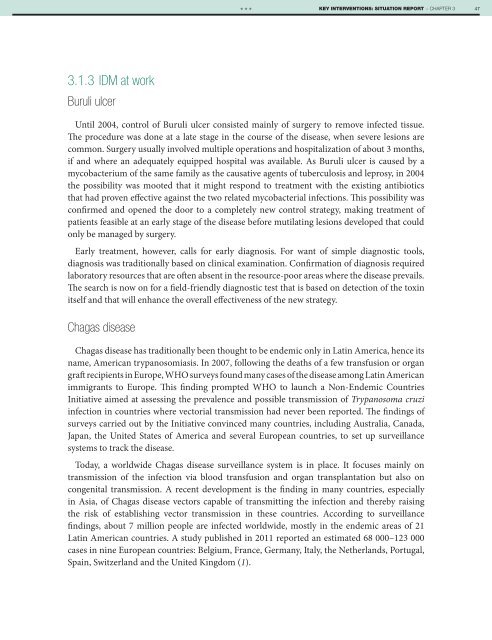1A9bnbK
1A9bnbK
1A9bnbK
You also want an ePaper? Increase the reach of your titles
YUMPU automatically turns print PDFs into web optimized ePapers that Google loves.
***<br />
KEY INTERVENTIONS: SITUATION REPORT − CHAPTER 3<br />
47<br />
3.1.3 IDM at work<br />
Buruli ulcer<br />
Until 2004, control of Buruli ulcer consisted mainly of surgery to remove infected tissue.<br />
The procedure was done at a late stage in the course of the disease, when severe lesions are<br />
common. Surgery usually involved multiple operations and hospitalization of about 3 months,<br />
if and where an adequately equipped hospital was available. As Buruli ulcer is caused by a<br />
mycobacterium of the same family as the causative agents of tuberculosis and leprosy, in 2004<br />
the possibility was mooted that it might respond to treatment with the existing antibiotics<br />
that had proven effective against the two related mycobacterial infections. This possibility was<br />
confirmed and opened the door to a completely new control strategy, making treatment of<br />
patients feasible at an early stage of the disease before mutilating lesions developed that could<br />
only be managed by surgery.<br />
Early treatment, however, calls for early diagnosis. For want of simple diagnostic tools,<br />
diagnosis was traditionally based on clinical examination. Confirmation of diagnosis required<br />
laboratory resources that are often absent in the resource-poor areas where the disease prevails.<br />
The search is now on for a field-friendly diagnostic test that is based on detection of the toxin<br />
itself and that will enhance the overall effectiveness of the new strategy.<br />
Chagas disease<br />
Chagas disease has traditionally been thought to be endemic only in Latin America, hence its<br />
name, American trypanosomiasis. In 2007, following the deaths of a few transfusion or organ<br />
graft recipients in Europe, WHO surveys found many cases of the disease among Latin American<br />
immigrants to Europe. This finding prompted WHO to launch a Non-Endemic Countries<br />
Initiative aimed at assessing the prevalence and possible transmission of Trypanosoma cruzi<br />
infection in countries where vectorial transmission had never been reported. The findings of<br />
surveys carried out by the Initiative convinced many countries, including Australia, Canada,<br />
Japan, the United States of America and several European countries, to set up surveillance<br />
systems to track the disease.<br />
Today, a worldwide Chagas disease surveillance system is in place. It focuses mainly on<br />
transmission of the infection via blood transfusion and organ transplantation but also on<br />
congenital transmission. A recent development is the finding in many countries, especially<br />
in Asia, of Chagas disease vectors capable of transmitting the infection and thereby raising<br />
the risk of establishing vector transmission in these countries. According to surveillance<br />
findings, about 7 million people are infected worldwide, mostly in the endemic areas of 21<br />
Latin American countries. A study published in 2011 reported an estimated 68 000–123 000<br />
cases in nine European countries: Belgium, France, Germany, Italy, the Netherlands, Portugal,<br />
Spain, Switzerland and the United Kingdom (1).


